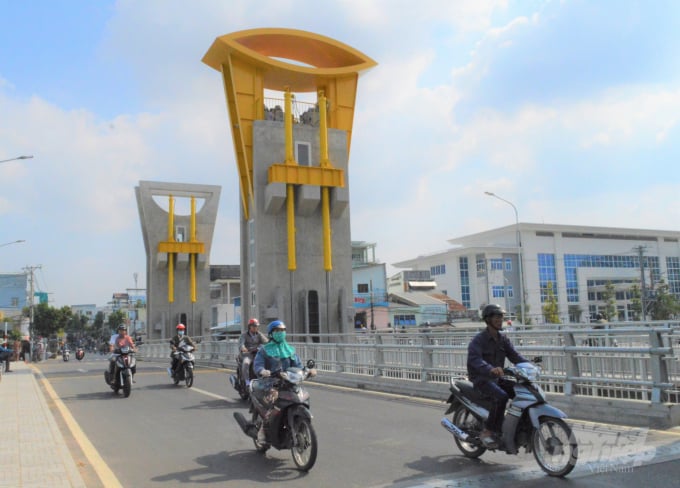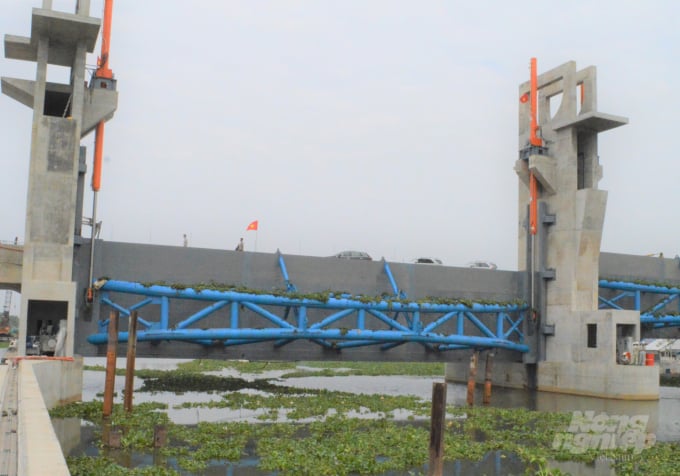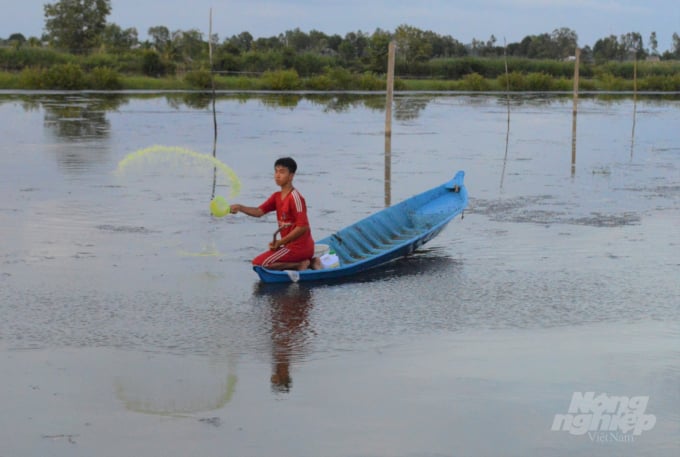June 20, 2025 | 10:59 GMT +7
June 20, 2025 | 10:59 GMT +7
Hotline: 0913.378.918
June 20, 2025 | 10:59 GMT +7
Hotline: 0913.378.918
Mr. Le Huu Toan, Deputy Director of the Kien Giang Department of Agriculture and Rural Development, said that the province developed and put into operation ten irrigation works between 2019 and 2020, totaling VND 814 billion in investment.

Investment in key irrigation works has helped Kien Giang province control salinity, manage fresh water, develop effective agricultural production and aquaculture. Photo: Trung Chanh.
In which Kenh Cut (Rach Gia city) is included in the irrigation management project for rural development in the Mekong Delta, the World Bank's capital (WB6). The culvert is part of an emergency works project to address drought and saltwater intrusion in the Cai Be riverfront region, which includes the Ca Lang canal culvert and the Dap Da culvert (Chau Thanh district), with an investment capital of VND 58 billion and 31 billion, respectively. Dong and Song Kien culverts (Rach Gia city) received a capital investment of VND 198 billion.
The construction investment project to restore and upgrade the An Bien - An Minh sea dyke has completed and commissioned six culverts, including the Saturday canal culvert, the Xeo Doi culvert, the Xeo Quao culvert, the Thuong Luong culvert, the Ro Ghe culvert, and the Xeo Nhao culvert, totaling VND 256 billion.

Investment in key irrigation projects has helped Kien Giang province control salinity, manage fresh water, develop effective agricultural production and aquaculture. Photo: Trung Chanh.
According to Mr. Toan, these are vital and urgent projects necessary to execute the provisions of the Government's Resolution 120/NQ-CP dated November 17, 2017 on the Mekong Delta's sustainable development. As a result, it has aided in strengthening the ability to adapt to climate change, reduce drought and saltwater intrusion, properly control salt and fresh water, and promote rice and aquaculture output.
Due to the excellent use of irrigation works' investment, Kien Giang province has topped the Mekong Delta area in rice production over the last several years, with a projected output of 4.5 million tons in 2021. Aquaculture is also seeing rapid expansion, particularly brackish shrimp farming, where the culture area exceeds the proposed plan and the estimated production exceeds 100,000 tons.

Districts in the U Minh Thuong area of Kien Giang province have converted most of the monocropculture rice cultivation area to shrimp-rice rotation, with much higher economic efficiency. Photo: Trung Chanh.
Within agriculture, there has been a shift away from monoculture rice cultivation with low yields and toward aquaculture, specifically toward developing rotational production of one rice crop and one shrimp crop (the rice – shrimp model), in order to increase production efficiency and income for farmers.
An Minh district, with about 39,000 hectares of rice-shrimp agriculture, has the province's greatest production area following this strategy. Mr. Le Van Khanh, Head of An Minh district's Agriculture and Rural Development Department, said that by the end of September, farmers in the district had improved and cleaned 23,665ha and finished planting 13,382/ 21,000ha as planned for the rice-shrimp harvest 2021-2022. Farmers mostly use the technique of planting seeds on square banks and then uprooting to transplant in order to reduce the quantity of rice seed used, maintain a sparse field density, and save costs.
Along with the rice-shrimp producing region, An Minh district includes a planned aquaculture and agricultural area beneath the canopy of coastal protection trees. The district continues to encourage blood cockle harvesting, green mussel harvesting, silk clam harvesting, and sea mussel harvesting in order to increase harvested area and production. Aquaculture output will increase by more than 13,000 tons in the final months of the year.
By 2020, the value of items produced on one hectare of arable land in Kien Giang will average VND 100 million per hectare, an increase of VND 22 million per hectare over the period prior to Resolution 120's implementation. Aquatic goods were valued at VND 130 million per hectare of aquaculture water surface, an increase of roughly VND 30 million per hectare over 2017.
Translated by Linh Linh
![Turning wind and rain into action: [9] Digitizing hydrometeorological data in response to climate change](https://t.ex-cdn.com/nongnghiepmoitruong.vn/608w/files/news/2025/06/17/z6704423696987_15fd32ffc26d590d204d520c9dac6786-nongnghiep-165943.jpg)
(VAN) Farmers have begun accessing hydrometeorological applications to adjust their cropping schedules, aiming to ensure productivity and adapt to climate change.
![Turning wind and rain into action: [8] Real-time salinity detection and early warning technology](https://t.ex-cdn.com/nongnghiepmoitruong.vn/608w/files/news/2025/06/17/z6704423696987_15fd32ffc26d590d204d520c9dac6786-nongnghiep-151127.jpg)
(VAN) Thanks to the integration of modern hydrological-hydraulic models, remote sensing technologies, and artificial intelligence, the accuracy of hydrological forecasting has significantly improved.
![Turning wind and rain into action: [7] Early disaster warnings help marine farmers minimize losses](https://t.ex-cdn.com/nongnghiepmoitruong.vn/608w/files/news/2025/06/17/z6704423696987_15fd32ffc26d590d204d520c9dac6786-nongnghiep-142942.jpg)
(VAN) In recent years, thanks to early disaster warnings and forecasting, marine farmers in Khanh Hoa province have been able to reduce risks and losses, thereby improving production efficiency.
![Turning wind and rain into action: [6] ‘Four on-the-spot’ disaster management software](https://t.ex-cdn.com/nongnghiepmoitruong.vn/608w/files/news/2025/06/17/e5a48259d6a262fc3bb3-nongnghiep-183800.jpg)
(VAN) By simply activating the scenario on the disaster management software, the relevant authorities immediately know how many households need to be evacuated, where to evacuate them to, and by what means of transportation…
![Turning wind and rain into action: [5] Hue applies modern technology in disaster forecasting](https://t.ex-cdn.com/nongnghiepmoitruong.vn/608w/files/news/2025/06/17/z6704423696987_15fd32ffc26d590d204d520c9dac6786-nongnghiep-093938.jpg)
(VAN) In Hue city, modern technology has recently been applied in meteorological and hydrological forecasting and warning, helping to reduce the damage caused by natural disasters.

(VAN) A cutting-edge farming technique being implemented on an experimental ranch in Arizona's Sonoran Desert has already saved a billion gallons of water over five years, according to Civil Eats.

(VAN) Poultry and pig production and the environment can be boosted through enhanced water technology, according to new research.